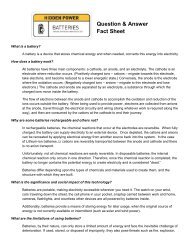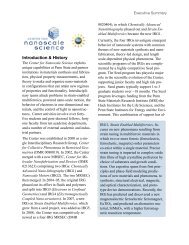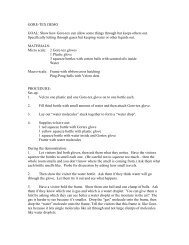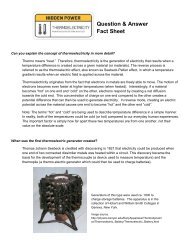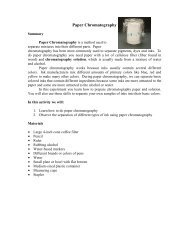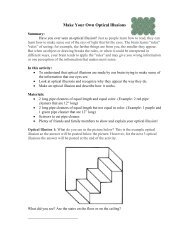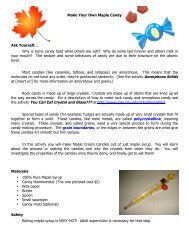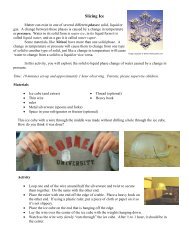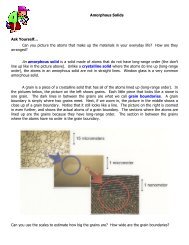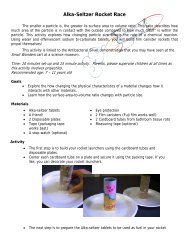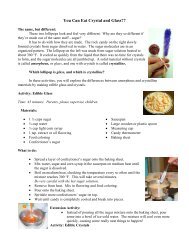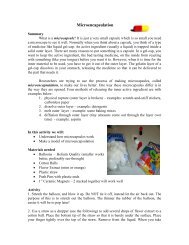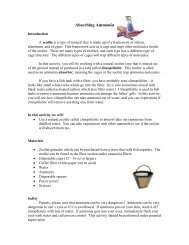Color Mixing with Roy G. Biv - the Center for Nanoscale Science - an ...
Color Mixing with Roy G. Biv - the Center for Nanoscale Science - an ...
Color Mixing with Roy G. Biv - the Center for Nanoscale Science - an ...
Create successful ePaper yourself
Turn your PDF publications into a flip-book with our unique Google optimized e-Paper software.
<strong>Color</strong> <strong>Mixing</strong> <strong>with</strong> <strong>Roy</strong> G. <strong>Biv</strong><br />
Summary:<br />
Have you ever wondered why we see color? We see light that bounces off things<br />
around us. In <strong>the</strong> background section, we will talk about <strong>the</strong> how our eyes allow us to see.<br />
A reference at <strong>the</strong> end of <strong>the</strong> activity explains in detail <strong>the</strong> <strong>an</strong>atomy of <strong>the</strong> eye. After we<br />
discover how our eyes “see,” we will move on to <strong>an</strong> activity that explains color.<br />
Background: Vision<br />
Light that reflects off of objects around us is imaged onto <strong>the</strong> retina by <strong>the</strong> lens.<br />
The retina is responsible <strong>for</strong> detecting <strong>the</strong> light from <strong>the</strong>se images <strong>an</strong>d <strong>the</strong>n sending<br />
signals to <strong>the</strong> brain along <strong>the</strong> optic nerve. The brain decodes <strong>the</strong>se images into <strong>the</strong><br />
in<strong>for</strong>mation that we know as vision.<br />
Two different cells in <strong>the</strong> retina respond to light: <strong>the</strong> rod cells <strong>an</strong>d <strong>the</strong> cone cells.<br />
These cells were named because of <strong>the</strong>ir shape when viewed under a microscope. The<br />
cones in our retina are sensitive to color. Although, <strong>the</strong> rods c<strong>an</strong>not detect color <strong>the</strong>y are<br />
very sensitive to light at low levels. The rod cells are responsible <strong>for</strong> our night vision.<br />
Our eyes contain three types of cones. If you look at <strong>the</strong> graph below, you c<strong>an</strong> see<br />
each cone is able to detect a r<strong>an</strong>ge of colors. Even though each cone is most sensitive to a<br />
specific color of light <strong>the</strong>y also c<strong>an</strong> detect o<strong>the</strong>r colors. The three types of cones are<br />
commonly labeled by <strong>the</strong> color <strong>the</strong>y are most sensitive (blue, green <strong>an</strong>d red). However,<br />
we c<strong>an</strong> see m<strong>an</strong>y o<strong>the</strong>r colors th<strong>an</strong> red blue <strong>an</strong>d green. The overlap of <strong>the</strong> cones allows us<br />
to see m<strong>an</strong>y o<strong>the</strong>r colors. For example, <strong>the</strong> color yellow results from green <strong>an</strong>d red cones<br />
being stimulated while <strong>the</strong> blue cones have very little stimulation.
Our eyes are detectors. When <strong>the</strong> cones are stimulated by light <strong>the</strong>y send signals<br />
to <strong>the</strong> brain. The brain is <strong>the</strong> actual interpreter of color. When all <strong>the</strong> cones are stimulated<br />
equally <strong>the</strong> brain perceives <strong>the</strong> color as white. We also perceive <strong>the</strong> color white when our<br />
rods are stimulated. Unlike cones, rods are able to detect light at a much lower level. This<br />
is why we see only black <strong>an</strong>d white in dimly lighted rooms or while out viewing a star<br />
filled night sky.<br />
In this activity we will:<br />
• Underst<strong>an</strong>d that light is a <strong>for</strong>m of radiation that c<strong>an</strong> be broken into m<strong>an</strong>y<br />
wavelengths; <strong>the</strong>se wavelengths in <strong>the</strong> visible spectrum of light are <strong>the</strong> colors we<br />
see.<br />
• To recognize how we see color. If possible, also to recognize what colors are seen<br />
by colorblind people that may be present.<br />
• Identify <strong>the</strong> three primary colors of light as red, blue <strong>an</strong>d green. Distinguish that<br />
every o<strong>the</strong>r color is caused by <strong>an</strong> overlap of <strong>the</strong> primary colors.<br />
Materials:<br />
• 3 flashlights<br />
• Red, green <strong>an</strong>d blue light bulbs <strong>for</strong> flashlights. ** If available, 3 colored LED<br />
flashlights work <strong>the</strong> best to generate a single wavelength of light. **<br />
• <strong>Color</strong>ed construction paper, o<strong>the</strong>r colored items such as clothing<br />
• White paper or white surface<br />
• 1 5”x7” notecard to make “color mixer” (Piece of cardboard or tagboard <strong>with</strong><br />
a square hole cut in <strong>the</strong> center)
Activity:<br />
When we look at <strong>the</strong> visible light, we see colors. Although <strong>the</strong>re are m<strong>an</strong>y colors<br />
that make up our surroundings, colors from just three areas of <strong>the</strong> spectrum could be<br />
mixed to <strong>for</strong>m <strong>an</strong>y o<strong>the</strong>r color, including white! These three colors are also called<br />
“primary colors.”<br />
What are <strong>the</strong> three primary colors? (Hint: think about <strong>the</strong> types of cones in our<br />
eyes) List <strong>the</strong> three primary colors below:<br />
___________________, ___________________ <strong>an</strong>d ___________________<br />
1. Using your three sources of light (red, blue <strong>an</strong>d green) to mix <strong>the</strong> colors. When<br />
mixing <strong>the</strong> colors, shine <strong>the</strong> colors added through <strong>the</strong> color mixer onto a white<br />
wall, piece of paper or cardboard (hold <strong>the</strong> color mixer about 4-6 inches away<br />
from <strong>the</strong> white wall or white posterboard). Then, take your flashlight <strong>an</strong>d shine it<br />
through <strong>the</strong> square in <strong>the</strong> middle of your <strong>Color</strong> Mixer. The flashlight should be no<br />
more th<strong>an</strong> 6-8 inches away from <strong>the</strong> <strong>Color</strong> Mixer.<br />
<strong>Color</strong>s Added: Predicted <strong>Color</strong>: Actual (Resulting) <strong>Color</strong>:<br />
Red + Blue + Green<br />
Red + Blue<br />
Red + Green<br />
Green + Blue<br />
2. How did your predictions match <strong>the</strong> actual colors that resulted? Are <strong>an</strong>y<br />
surprising?<br />
__________________________________________________________________<br />
__________________________________________________________________
The primary colors shown to <strong>the</strong> left are Red, Blue<br />
<strong>an</strong>d Green. When <strong>the</strong>y combine, <strong>the</strong>y make o<strong>the</strong>r<br />
colors. Red + Blue + Green combine to make<br />
white. Red <strong>an</strong>d Green combine to make Yellow.<br />
Blue <strong>an</strong>d Green make Cy<strong>an</strong>. Red <strong>an</strong>d Blue make<br />
Magenta<br />
3. Find some colored objects around your house; list <strong>the</strong> objects in <strong>the</strong> table below<br />
according to <strong>the</strong>ir color in white light. Examples: clothing, construction paper, be<br />
creative!!<br />
4. Test <strong>the</strong>se objects that you find in red, green <strong>an</strong>d blue light. Make your prediction<br />
in <strong>the</strong> table below <strong>an</strong>d <strong>the</strong>n note <strong>the</strong> actual color that results.<br />
<strong>Color</strong> of object <strong>Color</strong> of light used<br />
(white light) (red, green or blue)<br />
1. Red<br />
Green<br />
Blue<br />
2. Red<br />
Green<br />
Blue<br />
3. Red<br />
Green<br />
Blue<br />
4 Red<br />
Green<br />
Blue<br />
5. Red<br />
Green<br />
Blue<br />
6. Red<br />
Green<br />
Blue<br />
7. Red<br />
Green<br />
Blue<br />
8. Red<br />
Green<br />
Blue<br />
Predicted <strong>Color</strong><br />
Actual (Resulting)<br />
<strong>Color</strong>
Extension Activities:<br />
1. Art: Where else is color mixing used?<br />
Have you ever used markers or paints to mix colors <strong>an</strong>d create new ones? Do you get <strong>the</strong><br />
same results from mixing colors of light as you do <strong>with</strong> markers or paints? Make your<br />
prediction <strong>an</strong>d <strong>the</strong>n use markers or paint on white paper to test your <strong>the</strong>ory. What are<br />
some of <strong>the</strong>se similarities <strong>an</strong>d differences when you mix colored pigments <strong>an</strong>d colored<br />
light?<br />
2. Bot<strong>an</strong>y/Scientific Method/Technology: Growing pl<strong>an</strong>ts, <strong>the</strong> practical side of color<br />
mixing.<br />
Does <strong>the</strong> color of light affect <strong>the</strong> way pl<strong>an</strong>ts grow? If you have indoor pl<strong>an</strong>ts that your<br />
parents do not mind you experimenting <strong>with</strong>, design <strong>an</strong> experiment to see if light effects<br />
pl<strong>an</strong>t growth. Use white light (sunlight) as your control. You c<strong>an</strong> add o<strong>the</strong>r pl<strong>an</strong>ts to<br />
sources of red, green <strong>an</strong>d blue light. Remember to design your hypo<strong>the</strong>sis be<strong>for</strong>e you<br />
experiment.<br />
3. Biology/Technology: What is it like to be color blind?<br />
What is it like to be color blind? Do <strong>an</strong> internet search to find in<strong>for</strong>mation on colorblindness.<br />
What is <strong>the</strong> most common type of color-blindness? What is it like <strong>for</strong> a person<br />
to be color blind? Are <strong>the</strong>re <strong>an</strong>y <strong>an</strong>imals that are color blind?<br />
4. Animals <strong>an</strong>d colored vision.<br />
M<strong>an</strong>y <strong>an</strong>imals do not have color vision: <strong>the</strong> ability to discern different wavelengths<br />
evolved in <strong>an</strong>imals that became diurnal, or active in <strong>the</strong> daytime. Among <strong>the</strong>se, birds are<br />
especially color sensitive. Some have four or more cone pigments, allowing <strong>the</strong>m to<br />
distinguish more accurately among colors th<strong>an</strong> we do (probably seeing more shades), <strong>an</strong>d<br />
to see into <strong>the</strong> ultraviolet r<strong>an</strong>ge, which we c<strong>an</strong>not.<br />
Most primates o<strong>the</strong>r th<strong>an</strong> hum<strong>an</strong>s have just two visual pigments, one <strong>for</strong> short (blue)<br />
wavelengths, <strong>an</strong>d one that varies in different <strong>an</strong>imals but detects light somewhere in <strong>the</strong><br />
red to green part of <strong>the</strong> spectrum. Familiar <strong>an</strong>imals such as dogs <strong>an</strong>d cats also have two<br />
types of cones. Old World monkeys have three cone types, as hum<strong>an</strong>s do.<br />
Some invertebrates have color vision: like birds, some insects c<strong>an</strong> see ultraviolet light.<br />
Insects also have different screening materials in <strong>the</strong> corneal covering of <strong>the</strong>ir eye facets;<br />
this allows <strong>for</strong> tuning different eye units (called ommatidia) to different wavelengths.<br />
References:<br />
For more in<strong>for</strong>mation on <strong>the</strong> <strong>an</strong>atomy of <strong>the</strong> eye:<br />
http://retina.<strong>an</strong>atomy.upenn.edu/~l<strong>an</strong>ce/eye/eye.html<br />
<strong>Color</strong> blindness, <strong>an</strong>imal vision <strong>an</strong>d general vision in<strong>for</strong>mation:
http://faculty.washington.edu/chudler/eyecol.html<br />
http://lsvl.la.asu.edu/askabiologist/research/seecolor/rods<strong>an</strong>dcones.html<br />
Light <strong>an</strong>d <strong>the</strong> Electromagnetic Spectrum:<br />
http://imagine.gsfc.nasa.gov/docs/science/know_l1/emspectrum.html<br />
http://csep10.phys.utk.edu/astr162/lect/light/spectrum.html<br />
<strong>Color</strong> <strong>Mixing</strong>:<br />
http://en.wikipedia.org/wiki/Primary_colors



